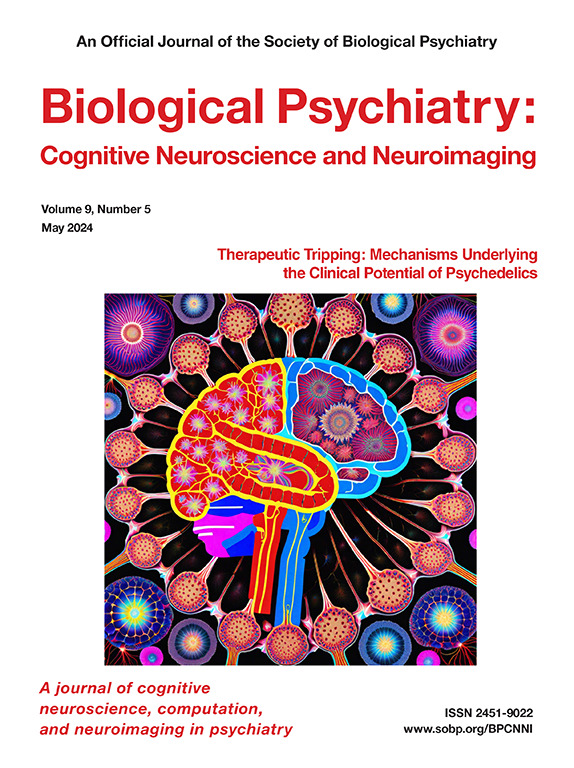Probing Neurophysiological Processes Related to Self-Referential Processing to Predict Improvement in Adolescents With Depression Receiving Cognitive Behavioral Therapy
IF 4.8
2区 医学
Q1 NEUROSCIENCES
Biological Psychiatry-Cognitive Neuroscience and Neuroimaging
Pub Date : 2025-05-01
DOI:10.1016/j.bpsc.2024.10.010
引用次数: 0
Abstract
Background
Cognitive behavioral therapy (CBT) is a gold-standard approach for treating major depressive disorder in adolescents. However, nearly half of adolescents receiving CBT do not improve. To personalize treatment, it is essential to identify objective markers that predict treatment responsiveness. To address this aim, we investigated neurophysiological processes related to self-referential processing that predicted CBT response among female adolescents with depression.
Methods
At baseline, female adolescents ages 13 to 18 years (N = 80) completed a comprehensive clinical assessment, and a self-referential encoding task was administered while electroencephalographic data were recorded. Baseline electroencephalographic data were utilized to identify oscillatory differences between healthy adolescents (n = 42) and adolescents with depression (n = 38). Following the baseline assessment, adolescents with depression received up to 12 weeks of CBT. Baseline differences in electroencephalographic oscillations between healthy adolescents and those with depression were used to guide CBT prediction analysis. Cluster-based event-related spectral perturbation analysis was used to probe theta and alpha event-related synchronization (ERS)/event-related desynchronization (ERD) response to negative and positive words.
Results
Baseline analyses showed that, relative to the healthy adolescents, adolescents with depression exhibited higher levels of frontal theta ERS and greater posterior alpha ERD. Multilevel modeling identified primary neural pretreatment predictors of treatment response: greater theta ERS in the right prefrontal cortex after the onset of negative words and lower alpha ERD in both the right prefrontal cortex and posterior cingulate cortex. ERS and ERD associations with treatment response remained significant, with baseline depressive and anxiety symptoms included as covariates in all analyses.
Conclusions
Consistent with prior research, results highlighted that relative to healthy adolescents, adolescents with depression are characterized by prominent theta synchronization and alpha desynchronization over the prefrontal cortex and posterior cingulate cortex, respectively. Cluster-based event-related spectral perturbation analysis also identified key mechanisms underlying depression-related self-referential processing that predicted improved symptoms during the course of CBT. Ultimately, a better characterization of the neural underpinnings of adolescent depression and its treatment may lead to more personalized interventions.
探究与自我暗示处理相关的神经生理过程,预测接受认知行为疗法的抑郁青少年的病情改善情况。
背景:认知行为疗法(CBT)是治疗青少年重度抑郁障碍(MDD)的金标准方法。然而,近一半的青少年在接受 CBT 治疗后病情并未得到改善。为了实现个性化治疗,必须确定预测治疗反应的客观指标。为实现这一目标,本研究调查了与自我参照处理相关的神经生理过程,这些过程可预测抑郁女性青少年的 CBT 反应:基线时,13-18 岁的女性青少年(人数=80)完成了一项全面的临床评估,并在记录脑电图(EEG)数据的同时执行了一项自我参照编码任务。基线脑电图数据用于识别健康青少年(HC,38 人)和抑郁青少年(MDD,42 人)之间的振荡差异。基线评估后,抑郁青少年接受了长达 12 周的 CBT 治疗。健康和抑郁青少年脑电图振荡的基线差异被用来指导 CBT 预测分析。基于聚类的事件相关频谱扰动分析(ERSP)探测了θ和α事件相关同步/不同步(ERS/ERD)对消极和积极词语的反应:基线分析表明,与健康青少年相比,抑郁青少年表现出更高水平的额叶θ ERS和更高的后部α ERD。多层次建模确定了治疗前预测治疗反应的主要神经因素:在消极词语出现后,右侧前额叶皮层(PFC)的θ ERS更高,右侧前额叶皮层和后扣带回皮层(PCC)的α ERD更低。在将基线抑郁症状和焦虑症状作为协变量纳入所有分析的情况下,ERS和ERD与治疗反应的关系仍然显著:与之前的研究一致,研究结果表明,与健康青少年相比,抑郁青少年的前脑皮层(PFC)和后脑皮层(PCC)分别具有突出的θ同步性和α非同步性。基于ERSP的聚类分析还确定了与抑郁相关的自我参照处理的关键机制,这些机制可预测CBT治疗过程中症状的改善。最终,对青少年抑郁症及其治疗的神经基础进行更好的描述,可能会带来更多个性化的干预措施。
本文章由计算机程序翻译,如有差异,请以英文原文为准。
求助全文
约1分钟内获得全文
求助全文
来源期刊

Biological Psychiatry-Cognitive Neuroscience and Neuroimaging
Neuroscience-Biological Psychiatry
CiteScore
10.40
自引率
1.70%
发文量
247
审稿时长
30 days
期刊介绍:
Biological Psychiatry: Cognitive Neuroscience and Neuroimaging is an official journal of the Society for Biological Psychiatry, whose purpose is to promote excellence in scientific research and education in fields that investigate the nature, causes, mechanisms, and treatments of disorders of thought, emotion, or behavior. In accord with this mission, this peer-reviewed, rapid-publication, international journal focuses on studies using the tools and constructs of cognitive neuroscience, including the full range of non-invasive neuroimaging and human extra- and intracranial physiological recording methodologies. It publishes both basic and clinical studies, including those that incorporate genetic data, pharmacological challenges, and computational modeling approaches. The journal publishes novel results of original research which represent an important new lead or significant impact on the field. Reviews and commentaries that focus on topics of current research and interest are also encouraged.
 求助内容:
求助内容: 应助结果提醒方式:
应助结果提醒方式:


